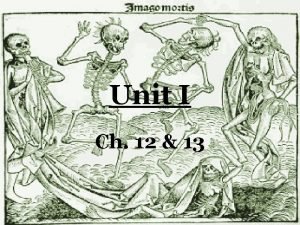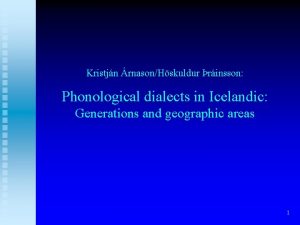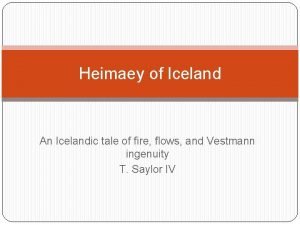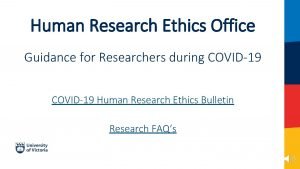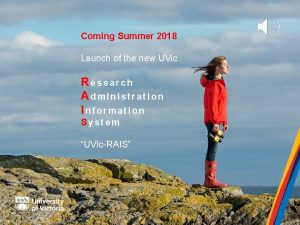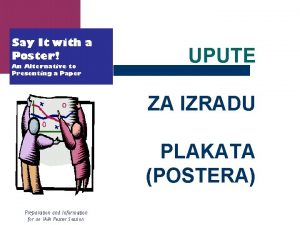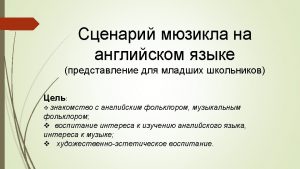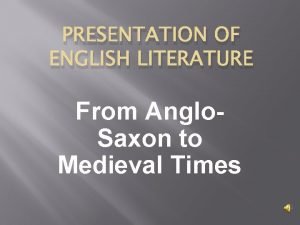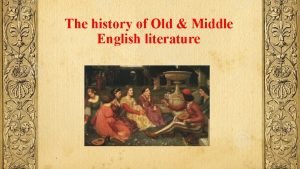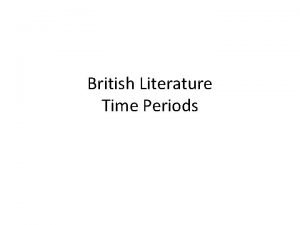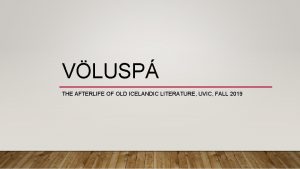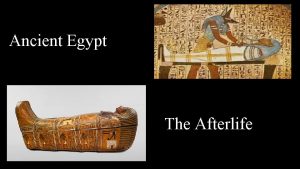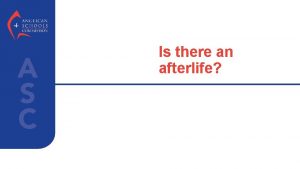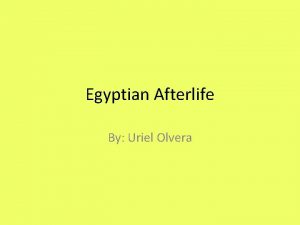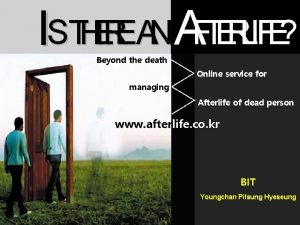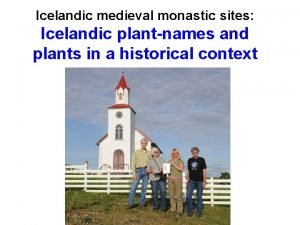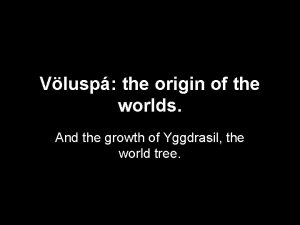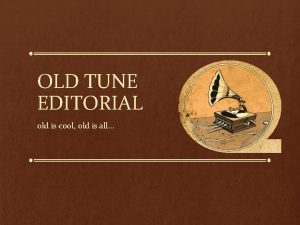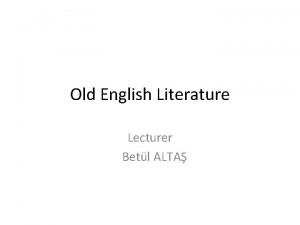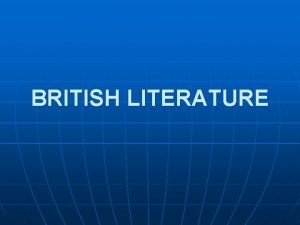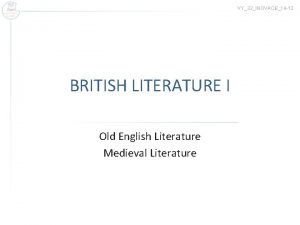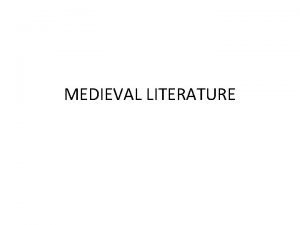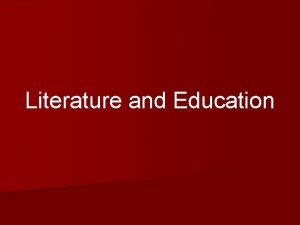VLUSP THE AFTERLIFE OF OLD ICELANDIC LITERATURE UVIC






















- Slides: 22

VÖLUSPÁ THE AFTERLIFE OF OLD ICELANDIC LITERATURE, UVIC, FALL 2019

OLD NORSE MEDIEVAL LITERATURE • Poetry (Eddic poems, Skaldic poetry, religious poetry) • Prose (Sagas of the Icelanders, King Sagas, Legendary sagas, Contemporary Sagas, Chivalric sagas, religious texts etc. ) • This huge corpus, produced in 12 th, 13 th and 14 th Centuries the was relatively unknown outside Iceland until the 17 th, 18 th and 19 th Centuries • The Skaldic Poetry is often found in the Sagas and at times is the source of certains scenes in the Sagas. • The complex metaphors used in the Skaldic poetry often refers to the myths about the ancient gods that the Eddic poems relate.

EDDUKVÆÐI (THE POETIC EDDA/ THE ELDER EDDA) • A term used about poems or lays devoted to the ancient Scandinavian gods (Odin, Thor, Freyja, Freyr, Loki etc. ) and to old Germanic heroes (Sigurd, Bryndhild, Gunnar, etc). • The most important manuscript that contains Eddic poems is Codex Regius (Royal Book/King‘s Book), written around 1270 in Iceland. It contains around 30 lays (or parts of lays), 11 of which are considered to be mythical poems, the rest is devoted to legendary heroes. • Another 8 -10 Eddic lays, found in other manuscripts, are generally published in modern editions of The Poetic Edda

THE CHRONOLOGY OF OLD NORSE MYTH BEFORE THE DAYS OF CREATION ÆSIR AND VANIR-GODS AT WAR EQUILIBRIUM (most of the myths take place here, this is the „present“) RAGNARÖK – THE END OF THE WORLD REBIRTH

VAL(V)A – SOOTHSAYER, SPÁ - PROPHECY • Völuspá is prophecy poem, a dream vision, an apocalyptic poem. • It can been compared with classical texts (Latin Sibylline Books, The Sibylline Oracles) and Old English texts (Prophecies of Merlin by Geoffrey of Monmouth ) that had been translated in Iceland (Merlínusspá) • 66 (67) stanzas, all spoken by the female „valva“, addressed to Odin • 1, 28 -30, 66 take place in the present • 2 -27 describe the past • 31 -65 describe the future

THORBJÖRG LITILVÖLVA There was in the settlement the woman whose name was Thorbjorg. She was a prophetess, and was called Litilvolva. . It was a custom of Thorbjorg, in the winter time, to make a circuit, and people invited her to their houses, especially those who had any curiosity about the season, or desired to know their fate. …, she was dressed in such wise that she had a blue mantle over her, with strings for the neck, and it was inlaid with gems quite down to the skirt. On her neck she had glass beads. On her head she had a black hood of lambskin, lined with ermine. A staff she had in her hand, with a knob thereon; it was ornamented with brass, and inlaid with gems round about the knob. Around her she wore a girdle of soft hair, and therein was a large skin-bag, in which she kept the talismans needful to her in her wisdom. She wore hairy calf-skin shoes on her feet, with long and strong-looking thongs to them, and great knobs of latten at the ends. On her hands she had gloves of ermine-skin, and they were white and hairy within. (From Eirik the Red’s Saga)

PAST AND PRESENT • 1 st. : The valva addresses Odin • 2 -5: The world‘s creation (9 worlds, sons of the gods lift the world, sun and moon appear) • 6 -8: Ordering of times and season, golden age of the gods • 9 -16: Creation of the dwarfs • 17 -20: Creation of Man (Ash and Elm (Embla)), Tree of Life (Ash Yggdrasil), Fate (3 maidens) • 21. -26: War between the gods (Æsir and Vanir), the giants try to rob Freyja, Thor reacts • 27 -30: The Secret Pledges of the Gods, Odin meets the valva, who sees far and wide

THE FUTURE (RAGNARÖK AND A NEW START) • 31 -35: Valkyries will come, Baldur will be killed by Höd, Loki is punished for his part in that • 36 -38: The landscape of Ragnarök (river, dales, 3 different halls) • 39 -52: The players of Ragnarök (muderers, old giantess, the wolfs Fenrir & Garm, red cock, Hrymr, World-serpent, Loki, the brother of Byleist, Surtr, giants) • 53 -58: Ragnarök (the fate of the gods): Odin fights the Fenrir Freyr fights Surt, Vidar kills Fenrir, Thor fights the serpent, the sund is darkened, earth sinks in the sea, Garm barks before Gaping-hel • 59 -65: The new World: Earth rises, gods gather again, golden tables reclaimed, Baldur returns and builds Valhöll with Höd and Hænir, they all live in Gimlé (the place sheltering us from Fire), Mighty ruler comes from on high (is this a Christian reference, or a poem describing an annual cirle? ) • 66: Closure: The valva sees a dim dragon flying, SHE (the valva/the earth) will now sink („nú mun hún sökkvast“)

FENRIR‘S OFFSPRING (WILL) SNATCH THE SUN (ST. 40)

HE REDDENS THE PLACE. . . LIKE BLOD (ST. 41)

SWART (BLACK) GROWS THE SUNSHINE (ST. 41)

GROANS THE ANCIENT TREE, FENRIR IS FREED (ST. 47)

BEFORE THE STONE DOORS THE DWARFS ARE GROANING (ST. 48)

THE WORLD-SERPENT LASHES THE WAVES (ST. 50)

THE ROCK-HILL CRASH. . HEAVEN IS CLEFT (ST. 52)

THE SUN IS DARKENED (ST. 57)

HIGH FLAMES PLAY AGAINST HEAVEN ITSELF (ST. 57)

I SEE UPRISING A SECOND TIME EARTH FROM THE OCEAN (ST. 59)

AND THE UNSOWN SHALL THE FIELDS BRING FORTH (ER. 63)

She begged them to bring to her those women who were acquainted with the lore needed for the exercise of the enchantments, and which is known by the name of Weird-songs, but no such women came forward. Then was search made throughout the homestead if any woman were so learned. Then answered Gudrid, "I am not skilled in deep learning, nor am I a wise-woman, although Halldis, my foster-mother, taught me, in Iceland, the lore which she called Weird-songs. “. . The women formed a ring round about, and Thorbjorg ascended the scaffold and the seat prepared for her enchantments. Then sang Gudrid the weird-song in so beautiful and excellent a manner, that to no one there did it seem that he had ever before heard the song in voice so beautiful as now. The spae-queen thanked her for the song. "Many spirits, " said she, "have been present under its charm, and were pleased to listen to the song, who before would turn away from us, and grant us no such homage. And now are many things clear to me which before were hidden both from me and others. And I am able this to say, that the dearth will last no longer, the season improving as spring advances…“ Afterwards the men went to the wise-woman, and each enquired after what he was most curious to know. She was also liberal of her replies, and what she said proved true. ” (From Eirk the Red’s Saga)

ERIK THE VIKING (1989) FEATURES A „VALVA“ CALLED FREYJA (EARTHA KITT)

SNORRA EDDA (THE PROSE EDDA, THE YOUNGER EDDA) • Generally it is believed that Snorri Sturluson (1179 -1241) composed this work, possibly around 1220. • It consists of four parts : 1. Prologue, 2. Gylfaginning (The Tricking of Gylfi), 3. Skáldskaparmál (Language of poetry) and 4. Háttatal (List of meters) • We are reading part 1 and 2 and the first two „myths“ in part 3. I would like you to pay special attention to stanzas 104 -110 of Hávamál, that was on today‘s reading list and the story in Skáldskaparmál about the mead of Poetry, p. 63 -64 in Faulkes‘s translation. • Gylfaginning is to some degree a „retelling“ of many of the myths that are related in the Eddic poems. Snorri quotes some the poems but also gives a general overview of the main characters in the myths. Snorra Edda is a textbook for 13 th Century Icelandic Poets
 Afterlife in zoroastrianism
Afterlife in zoroastrianism See you in the afterlife
See you in the afterlife The afterlife of anne boleyn
The afterlife of anne boleyn Icelandic school system
Icelandic school system Pron
Pron Icelandic tale
Icelandic tale Allyson hadwin
Allyson hadwin Uvic rais
Uvic rais Uvic rais
Uvic rais Engr 498 uvic
Engr 498 uvic Uvic social work
Uvic social work Once upon a time hansel and gretel
Once upon a time hansel and gretel What is your name and how old are you?
What is your name and how old are you? Running running running
Running running running Once upon a time there lived an old man and an old woman
Once upon a time there lived an old man and an old woman Old english literature presentation
Old english literature presentation Anglo saxons characteristics
Anglo saxons characteristics Anglo-saxon period in english literature
Anglo-saxon period in english literature Các loại đột biến cấu trúc nhiễm sắc thể
Các loại đột biến cấu trúc nhiễm sắc thể Biện pháp chống mỏi cơ
Biện pháp chống mỏi cơ Trời xanh đây là của chúng ta thể thơ
Trời xanh đây là của chúng ta thể thơ Phản ứng thế ankan
Phản ứng thế ankan Chó sói
Chó sói


